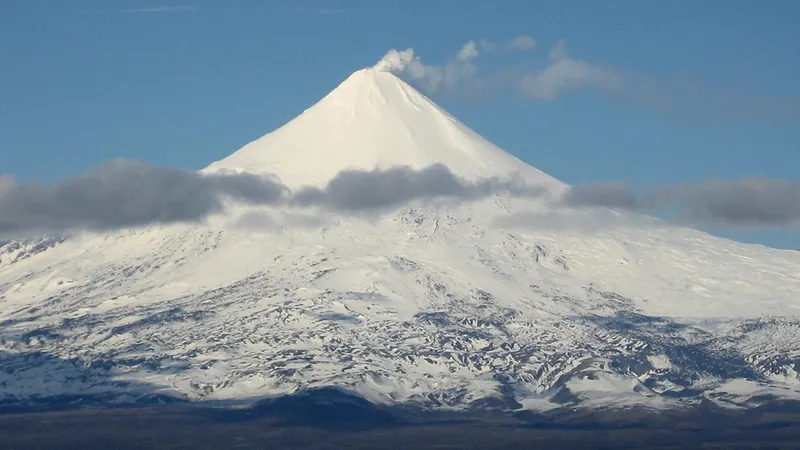
Unleashing Nature's Warning System: Glaciers Flow Faster Near Active Volcanoes!
2024-11-14
Author: John Tan
Unleashing Nature's Warning System: Glaciers Flow Faster Near Active Volcanoes!
Researchers have unveiled a groundbreaking discovery demonstrating that glaciers situated near active volcanoes exhibit significantly faster flow compared to those in more distant locations. With approximately 1,000 active volcanoes scattered across the globe, keeping a close eye on their activity is crucial for predicting potential eruptions. Surprisingly, only about 20% of these volcanoes are currently equipped with effective monitoring systems.
As Joe Mallalieu, a glaciologist at the University of Birmingham in the UK, explains, monitoring volcanic activity poses numerous challenges. Many active volcanoes are located in isolated areas where deploying traditional sensors is difficult, and the rugged volcanic terrain often damages monitoring equipment. However, scientists believe that the glaciers themselves could serve as a natural monitoring tool. "Changes in glacier characteristics might be indicative of changes in volcanic activity," Mallalieu noted, suggesting that glaciers could help warn us about impending eruptions.
The Research Breakthrough
In a quest to investigate this connection, Mallalieu and his team analyzed a vast global database containing information on over 214,000 glaciers, of which 2,729 were located within 5 kilometers of an active volcano. They defined an "active volcano" as one that has erupted within the last 12,000 years. The researchers focused primarily on glacier surface velocity, a key attribute since the heat generated by volcanic activity can significantly impact glacier dynamics.
"Glaciers located near active volcanoes flow approximately 50% faster than those farther away," Mallalieu found. This rapid flow can be attributed to increased geothermal heat, which is notably higher in areas of volcanic activity, raising the heat flux by as much as 1,000 milliwatts per square meter in some cases.
The Implications of Rapid Glacial Flow
Interestingly, the research revealed that glaciers situated within just 1 kilometer of an active volcano flow about 30% faster than those located between 2.5 to 5 kilometers away. Even after controlling for various environmental factors—such as air temperature, ice thickness, and glacier slope—the findings remained remarkably consistent.
These results highlight the potential for glaciers to act as indicators of subterranean activity. If changes in glacier velocity can be correlated with shifts in the movement of magma, it could pave the way for more effective volcano monitoring systems.
A Call for Further Research
Despite these promising findings, experts are calling for additional research to validate the conclusions. Taryn Black, a glaciologist at the University of Maryland, emphasized the need for concrete geothermal heat data to support the hypothesis that increased flow rates are directly linked to volcanic activity. She also pointed out the importance of accounting for precipitation types—whether falling as rain or snow—as this could further refine the understanding of glacial dynamics.
The Next Steps
The implications of this research are monumental. As climate change continues to alter global weather patterns, understanding how volcanic activity and glacial movements interconnect will become increasingly vital. The next logical step for researchers is to conduct more detailed studies on glacier velocities over time and their relationship with underground magma movements.
In conclusion, as we face a rapidly changing planet, the glaciers near active volcanoes may serve not just as magnificent natural wonders but also as vital early warning systems that could help save lives in and around volcanic regions. This innovative approach to monitoring volcanic activity could reshape our understanding of these natural giants and their potential threats. Stay tuned for more updates on this exciting research!


 Brasil (PT)
Brasil (PT)
 Canada (EN)
Canada (EN)
 Chile (ES)
Chile (ES)
 España (ES)
España (ES)
 France (FR)
France (FR)
 Hong Kong (EN)
Hong Kong (EN)
 Italia (IT)
Italia (IT)
 日本 (JA)
日本 (JA)
 Magyarország (HU)
Magyarország (HU)
 Norge (NO)
Norge (NO)
 Polska (PL)
Polska (PL)
 Schweiz (DE)
Schweiz (DE)
 Singapore (EN)
Singapore (EN)
 Sverige (SV)
Sverige (SV)
 Suomi (FI)
Suomi (FI)
 Türkiye (TR)
Türkiye (TR)